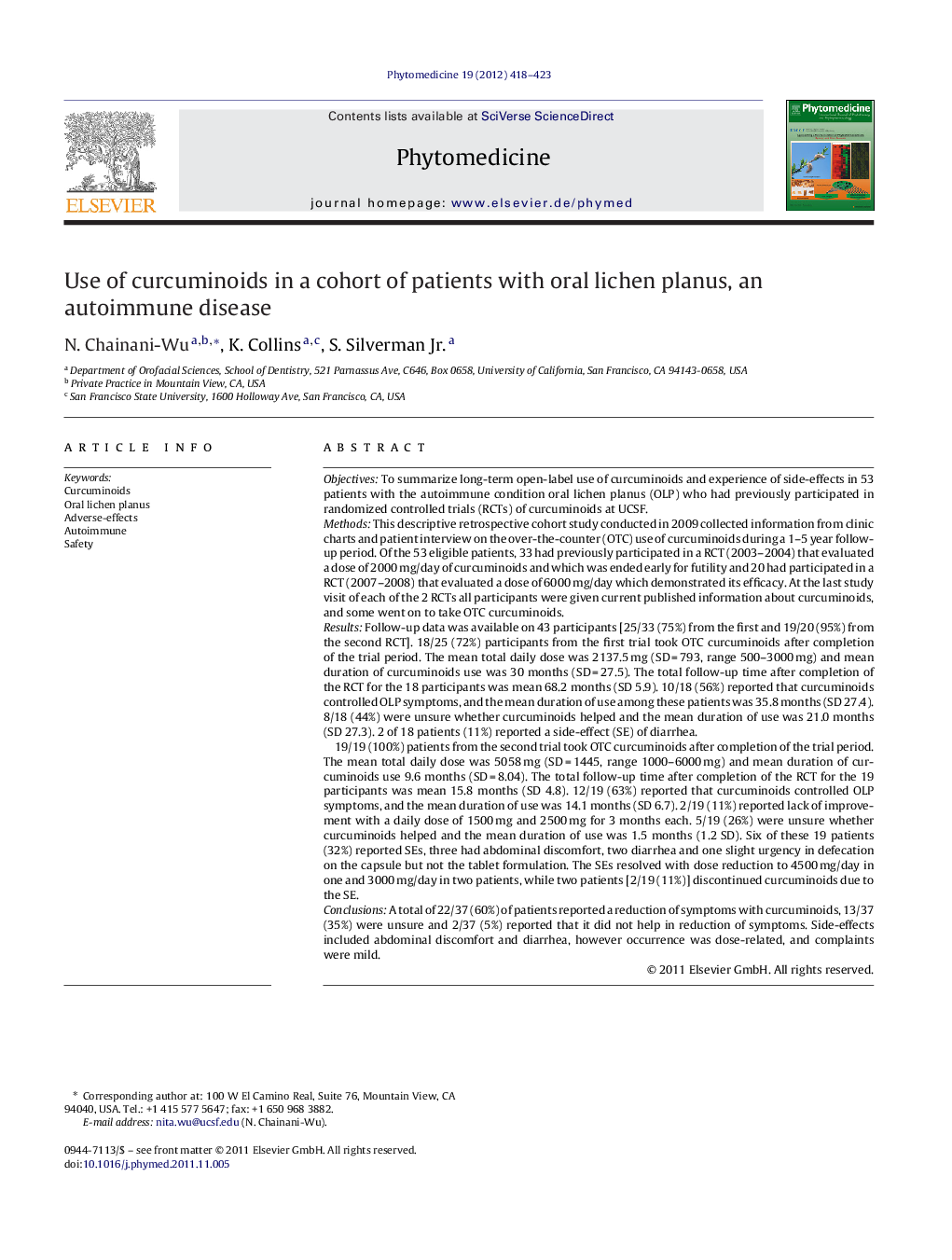| کد مقاله | کد نشریه | سال انتشار | مقاله انگلیسی | نسخه تمام متن |
|---|---|---|---|---|
| 2496798 | 1116166 | 2012 | 6 صفحه PDF | دانلود رایگان |

ObjectivesTo summarize long-term open-label use of curcuminoids and experience of side-effects in 53 patients with the autoimmune condition oral lichen planus (OLP) who had previously participated in randomized controlled trials (RCTs) of curcuminoids at UCSF.MethodsThis descriptive retrospective cohort study conducted in 2009 collected information from clinic charts and patient interview on the over-the-counter (OTC) use of curcuminoids during a 1–5 year follow-up period. Of the 53 eligible patients, 33 had previously participated in a RCT (2003–2004) that evaluated a dose of 2000 mg/day of curcuminoids and which was ended early for futility and 20 had participated in a RCT (2007–2008) that evaluated a dose of 6000 mg/day which demonstrated its efficacy. At the last study visit of each of the 2 RCTs all participants were given current published information about curcuminoids, and some went on to take OTC curcuminoids.ResultsFollow-up data was available on 43 participants [25/33 (75%) from the first and 19/20 (95%) from the second RCT]. 18/25 (72%) participants from the first trial took OTC curcuminoids after completion of the trial period. The mean total daily dose was 2137.5 mg (SD = 793, range 500–3000 mg) and mean duration of curcuminoids use was 30 months (SD = 27.5). The total follow-up time after completion of the RCT for the 18 participants was mean 68.2 months (SD 5.9). 10/18 (56%) reported that curcuminoids controlled OLP symptoms, and the mean duration of use among these patients was 35.8 months (SD 27.4). 8/18 (44%) were unsure whether curcuminoids helped and the mean duration of use was 21.0 months (SD 27.3). 2 of 18 patients (11%) reported a side-effect (SE) of diarrhea.19/19 (100%) patients from the second trial took OTC curcuminoids after completion of the trial period. The mean total daily dose was 5058 mg (SD = 1445, range 1000–6000 mg) and mean duration of curcuminoids use 9.6 months (SD = 8.04). The total follow-up time after completion of the RCT for the 19 participants was mean 15.8 months (SD 4.8). 12/19 (63%) reported that curcuminoids controlled OLP symptoms, and the mean duration of use was 14.1 months (SD 6.7). 2/19 (11%) reported lack of improvement with a daily dose of 1500 mg and 2500 mg for 3 months each. 5/19 (26%) were unsure whether curcuminoids helped and the mean duration of use was 1.5 months (1.2 SD). Six of these 19 patients (32%) reported SEs, three had abdominal discomfort, two diarrhea and one slight urgency in defecation on the capsule but not the tablet formulation. The SEs resolved with dose reduction to 4500 mg/day in one and 3000 mg/day in two patients, while two patients [2/19 (11%)] discontinued curcuminoids due to the SE.ConclusionsA total of 22/37 (60%) of patients reported a reduction of symptoms with curcuminoids, 13/37 (35%) were unsure and 2/37 (5%) reported that it did not help in reduction of symptoms. Side-effects included abdominal discomfort and diarrhea, however occurrence was dose-related, and complaints were mild.
Journal: Phytomedicine - Volume 19, Issue 5, 15 March 2012, Pages 418–423